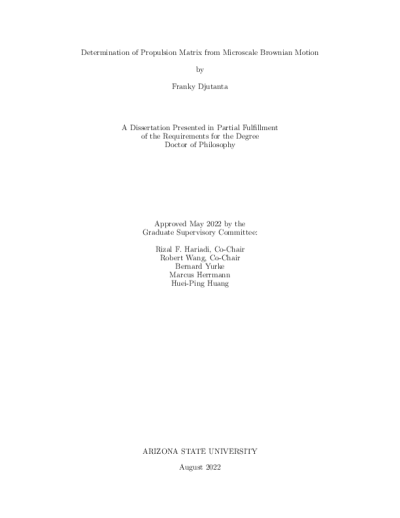
Description
The propulsion matrix provides a compact description of the locomotion of a single flagella molecular motor in a low Reynolds number environment. The locomotion properties of individual flagellar motors are central to bacterial behavior, including chemotaxis, pathogenesis, and biofilm formation. However, because conventional hydrodynamic measurement approaches require applied forces, torques, or fluid flows, it is not possible to directly measure the propulsion matrix for an individual microscale helical filament. Here, the limitations inherent to conventional measurement approaches are overcome using a combination of theoretical, experimental, and computational advancements. First, the relationship between the elements of the propulsion matrix with translational and rotational Brownian motion is derived using the fluctuation-dissipation theorem. Next, a volumetric fluorescent imaging using high resolution oblique plane microscopy with sufficient spatio-temporal resolution is conducted to resolve both translation and rotation of individual helical filaments isolated from E.coli's flagellar motor. Finally, a computational framework is developed to track individual helical filaments across six degrees of freedom, extract diffusion coefficients, and quantify the temporal correlation between translation and rotation. This study computed the maximum propulsion efficiency to be around 1.7%. Direct measurement of propulsion efficiency generally agrees with the ensemble and large-scale measurements previously performed using conventional hydrodynamic measurements. The findings suggest that the approach described here can be extended to more complex in-vitro experiments that evaluate microscale molecular motors. For example, evaluating sperm motility without inducing chemotaxis or utilizing a microfluidic setup.
Details
Title
- Determination of Propulsion Matrix from Microscale Brownian Motion
Contributors
- Djutanta, Franky (Author)
- Hariadi, Rizal (Thesis advisor)
- Wang, Robert (Thesis advisor)
- Yurke, Bernard (Committee member)
- Herrmann, Marcus (Committee member)
- Huang, Huei-Ping (Committee member)
- Arizona State University (Publisher)
Date Created
The date the item was original created (prior to any relationship with the ASU Digital Repositories.)
2022
Subjects
Resource Type
Collections this item is in
Note
- Partial requirement for: Ph.D., Arizona State University, 2022
- Field of study: Mechanical Engineering
